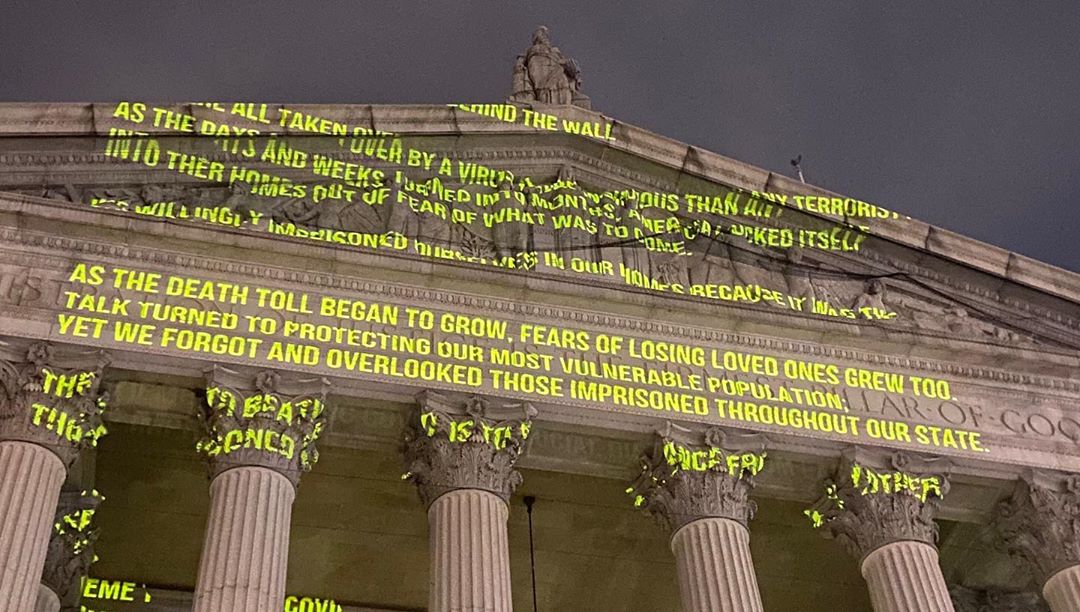
The artist Hank Willis Thomas is taking a stand on behalf of the world’s incarcerated population, many of whom are suffering as the coronavirus pandemic ravages prisons, with a new installation of his work, The Writing on the Wall. On Sunday night, the artist and Baz Dreisinger, executive director of the think tank Incarceration Nations Network, projected texts written by people in jail onto the facades of buildings tied to the criminal justice system in lower Manhattan.
“The Writing on the Wall has always been a kind of interruption: interjecting the voices of people behind bars around the world in public spaces, so people are compelled to read them,” Thomas and Dreisinger told Artnet News in an email. “Now more than ever… we wanted people to heed these voices. We wanted to literally center them at the heart of New York City in the middle of a pandemic as an insistence that they not be forgotten and must be attended to.”
Dreisinger has spent years collecting prisoners’ writings, sourced from some 50 countries. By sharing inmates’ words, the two hope to illuminate the plight of those behind bars during this global crisis, and inspire prison reform.
The pair first turned those passages into art last fall, for a public art installation on the High Line in New York City. The texts papered the walls of a cell-like installation, with essays, letters, poems, and even graphic novels giving voice to the experience of being locked up.
Hank Willis Thomas and Baz Dreisinger, The Writing on the Wall. Photo courtesy of the Incarceration Nations Network.
Today, prisoners face an even more dire situation. Living in close quarters and lacking protective gear, their conditions easily enable the spread of COVID-19. As of the first week of May, 20,119 people in prison had tested positive and there have been at least 304 related deaths, according to the Marshall Project, a nonprofit news outlet covering the US criminal justice system. Inmates have filed two lawsuits against New York City jails, alleging inadequate protection against the spread of the disease.
A class action lawsuit with three named plaintiffs is seeking a preliminary injunction to force the release of all medically vulnerable inmates, and take additional steps to contain the coronavirus in the federal jail. A similar suit was recently filed against the federal jail in Manhattan.
And even as several states and countries around the world begin to reopen after lockdown, the coronavirus remains a threat to the health and safety of those behind bars. The frightening new reality facing inmates today inspired Thomas and Dreisinger to bring back The Writing on the Wall for a global tour, this time using projection.
Hank Willis Thomas and Baz Dreisinger, The Writing on the Wall. Photo courtesy of the Incarceration Nations Network.
“We were thinking about what public art could look like in the context of a pandemic, and the idea of a projection seemed perfect: It’s visually arresting and impactful, even without being seen in person,” said Thomas. “It also allows the words and images to be front-and-center—it almost distills the installation to its critical content, the words themselves, which more than ever need to be read and heeded.”
In its current form, the work, which will be shown in several cities across the globe that have been hard hit by the pandemic, includes new writings inspired by the fear and uncertainty of the present moment.
“One piece—about ‘the voices behind the wall’ during the pandemic—was written last week by my loved one serving his 27th year of incarceration in New York and scared for his life,” wrote Dreisinger on Instagram.
Hank Willis Thomas and Baz Dreisinger, The Writing on the Wall. Photo courtesy of the Incarceration Nations Network.
“As the death toll began to grow, fears of losing loved ones grew too. Talk turned to protecting our most vulnerable population; yet we forgot and overlooked those imprisoned throughout our state,” proclaimed bold yellow type below the pediment on the neoclassical New York County Supreme Court.
In this first restaging of the work, Thomas and Dreisinger chose New York City buildings linked closely to mass incarceration. That included the Manhattan Detention Complex, also known as the Tombs, which mostly holds pre-trial detainees, who are still legally innocent until proven guilty, and the New York City courts complex.
The Tombs is “a decrepit jail in lower Manhattan that is inhumane and almost nedieval in its conditions before COVID-19, let alone during it,” said Thomas. “We wanted to make a statement about the failure of justice here—the idea that in the face of a pandemic, detention is death.”